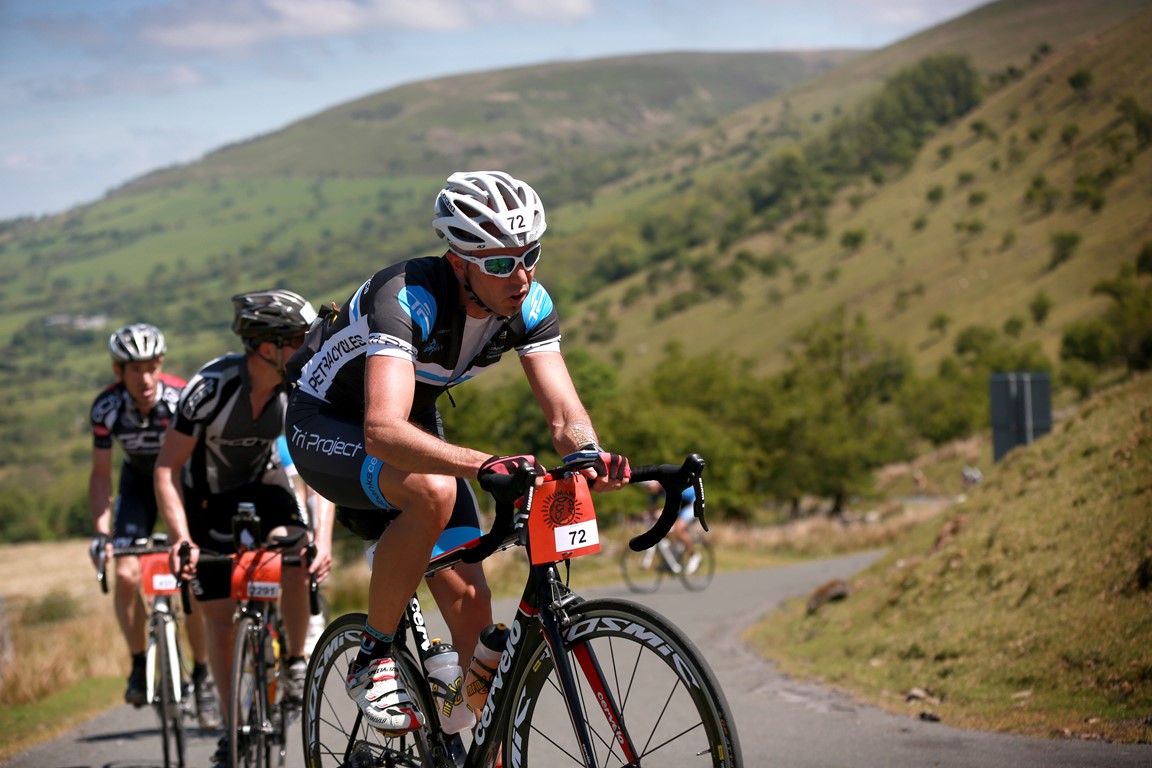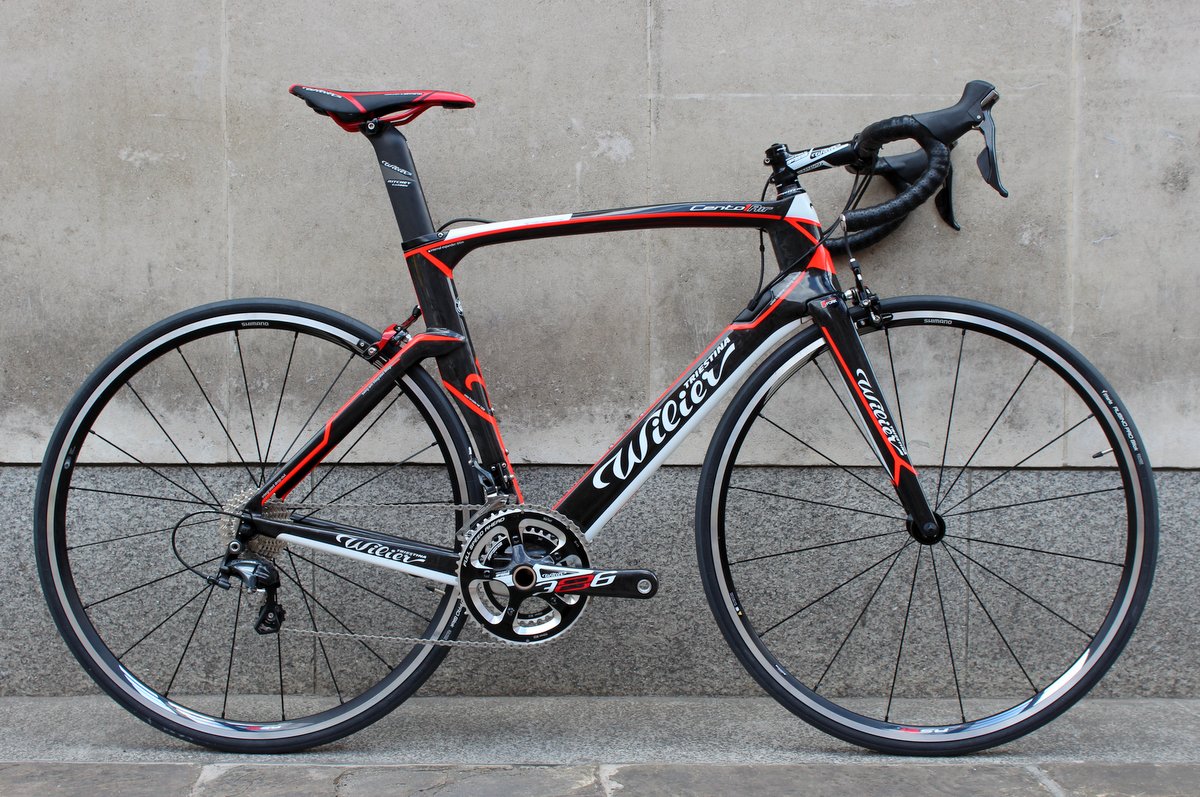Scott is one of cycling’s heavyweights, and their range for model year 2014 includes two intriguing additions.
The Addict, once Scott’s signature model but mothballed in favour of the aero-profiled Foil, is back with a vengeance, with a 995 gram frameset for the flagship SL – claimed to be the world’s first ‘production’ chassis to dip beneath kilo barrier.
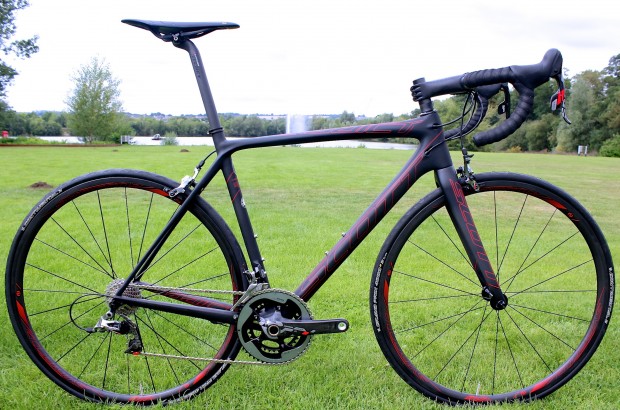
And the Solace, a brand new model, looks set to make an impact in an ever-increasing market for machines with sportive/comfort/endurance geometry.
We headed to the UK launch of the Swiss brand’s machines for the new model year. Here, we’ll focus in depth on the Addict SL, and give you an overview of the Foil range for model year 2014. Head this way for a similarly detailed examination of the endurance-inspired Solace, and an overview of the CR1 range.
Scott Addict
The Addict was once Scott’s calling card, one of the first significant salvos in the war for the title of world’s lightest frame. Many were surprised when a model whose profile almost eclipsed that of the brand was withdrawn from the range, but such was the desire among manufacturers to have a flagship aero bike (see also Specialized’s Venge, and Trek’s drastically overhauled Madone) that Scott dumped all its eggs in a basket named Foil (one of the best bikes we’ve ever had the pleasure to ride).
The Addict returns to Scott’s road line-up for model year 2014, and low weight is again its raison d’etre. The flagship Addict SL is the machine that understandably commands the greatest attention.
Military hardware
At its heart is a new carbon lay-up, one known to Scott as HMXSL, a blend of Toray’s T800S, bonded with a ‘nano resin’ to create a stronger composite, and T1000, the highest modulus fibre available, according to Scott, and one more commonly used in military applications.
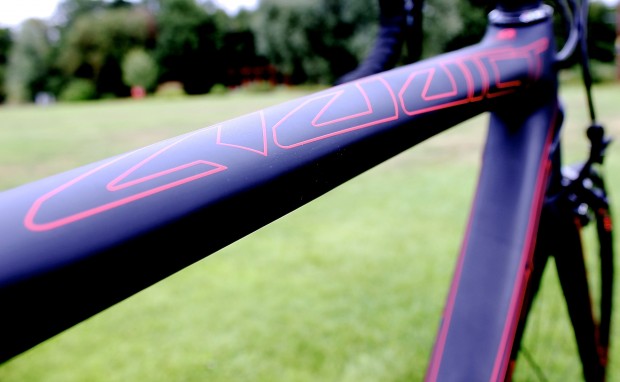
Just 18 per cent of the Addict SL’s chassis is comprised of T1000, given its expense and the greater skill required to mould it. Other components of the Addict SL’s DNA include the strategic use of M40J fibre, extremely stiff but lacking the impact resistance to be used on its own.
The obvious advantages to performance of using the stiffest, lightest, and strongest materials are tempered by an equally obvious disadvantage: they ain’t cheap. Not only are the materials expensive, but they require skilled labour.
Marginal gains
Lay-up, however, is only half the story. Design is the other. Scott’s engineers have clearly been busy during the Addict’s hiatus implementing Dave Brailsford’s theory of marginal gains. Such as? 14 grams saved in the weight of the dropouts from those used on the last Addict. How? The Addict SL’s carbon dropouts are hollow. Twelve grams have been saved on the seat stays; 16 grams reclaimed by using a monocoque design in the front triangle.
Scott’s engineers have clearly been busy during the Addict’s hiatus implementing Dave Brailsford’s theory of marginal gains. Hollow carbon dropouts yield a saving of 14 grams from those of its predecessor
The net result? The Addict SL frameset (not frame) tips the scales at a claimed 995 grams, compared to 1120 grams for its predecessor. Some vital statistics: the sub-kilo headline weight is for a 54cm frame, with rear mech hanger and an integrated hanger for the front mech, and with a fork steerer trimmed to 225mm.
Scott has focused upon the title of world’s lightest production frame. They concede that similarly featherweight framesets exist, but argue that such chassis are made in small batches, or for restricted use, typically for team issue. Only the Cervelo R5CA weighs the same. Cannondale’s SuperSix Evo Nano is 21 grams heavier at a claimed 1,016 grams. Trek’s flagship Madone 7 is some 70 grams heavier at a claimed 1065 grams.
Stiff upper
Design features intended to create stiffness, absent from the last Scott Addict but which have since become commonplace, are present and correct on the latest iteration. Deployment of a press fit bottom bracket has allowed the use of a sufficiently on-trend broad BB shell (86.5mm) and concomitantly oversized downtube. The bottom bracket on the new Addict is a claimed six per cent stiffer than its predecessor.
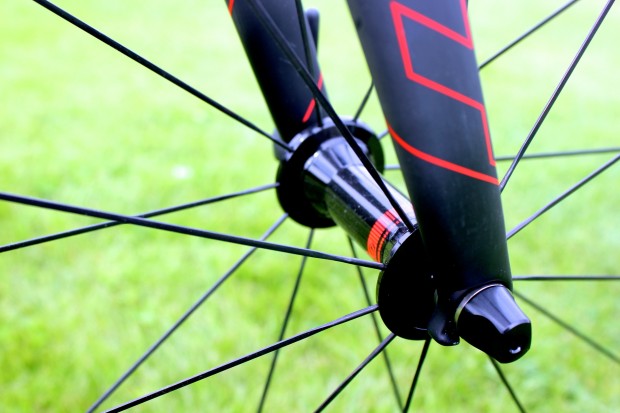
The tapered headtube, now de riguer on contemporary carbon frames, takes its place on the new Addict. Significantly, perhaps, Scott taper from a 1.25” lower bearing, an increasingly common choice as the trend among designers for 1.5” bearings subsides. Our man at Scott was uncertain why the Addict SL’s design team had opted for 1.25”, but given the model’s preoccupation with weight, and the reduced heft of a smaller bearing, it’s not impossible that shaving grams was the driving factor here.
Scott readily admit that comfort was not the overriding priority for the Addict (for that, they have the Solace), but if such a quality can be gauged solely by the deflection of the seatpost under a known load (how much it bends, effectively), then the new Addict is 39 per cent more comfortable than its predecessor.
Go with the (air) flow
The Foil remains the house aero bike, and the Addict makes no challenge to the former’s superiority in the wind tunnel. Lightness is its reason for being, and sculpted, aerofoiled tubes are notoriously heavier than conventional profiles.
Scott are claiming, however, greater aero efficiency for the new Addict in comparison with its predecessor. Bicycle designers quantify improvements in numbers, and a 7.8 watt saving at 45kph, courtesy of a 13.2 per cent drag reduction, is claimed for the Addict’s lightly-sculpted spars.
Lighten the load
There is little point in building an ultra lightweight chassis only to burden it with heavy components. Scott have dressed the Addict SL in a SRAM Red groupset with cable-operated, rather than hydraulic, rim brakes, and all manner of carbon finery, including Fizik’s range-topping Arione 00 saddle. The finishing kit is Ritchey’s Super Logic.
The Addict SL’s wheels have been built especially, and as an in-house project, via Scott’s Syncros sub-brand. Scott/Scyncros is claiming a weight of 1310 grams for its 28mm deep, full-carbon RL1.0 hoops, and shod with Continental Grand Prix 4000S tyres.
The bottom line
A bicycle with a 955 gram chassis, rolling on full carbon hoops and dressed in flagship components from a host of major brands, is not going to be cheap, and at £6999, the Addict SL is unlikely to be an impulse buy. The reward for such a hefty investment, however, is a far from hefty steed: a claimed 5.8kg, or 1kg below the UCI’s weight limit. When Orica-GreenEDGE and IAM Cycling roll into the high mountains, the Addict SL is likely to be the machine their climbers pluck from the quiver. Theirs, however, will be heavier than the Addict SL.
Significant others
The Team Issue heads the line-up of the remaining three machines in the Addict range. Its chassis is made with Scott’s Toray T800 HMX lay-up, which yields a claimed weight of 790g for the frame and 300g for the fork – still far from heavy. Built with Shimano Dura Ace 9000 and house Syncros 1.1 full carbon clinchers, the claimed overall weight is a UCI-friendly 6.17kg.
The Addict range is completed with the ’10’ and the ’20’, both fashioned from a Toray T700 lay-up that Scott call HMF, and which tips the scales at a claimed 860g for the frame and 360g for the fork. The Ultegra mechanical-specced ’10’, which rolls on Syncros 1.5 aluminium clinchers, costs £2799. The Addict ’20’, fitted with Shimano 105 shifting and RS11 wheels, and, surprisingly, non-series chainset and brake calipers, weighs a claimed 7.73kg and costs £2199.
Scott Foil
Few, if any, of cycling’s bigger brands is without an aero road bike, and the Foil, introduced three years ago, is Scott’s offering. Simon Gerrans claimed the model’s first Tour de France victory this year with victory in Calvi, the last of the hundredth Tour’s three stages on Corsica.
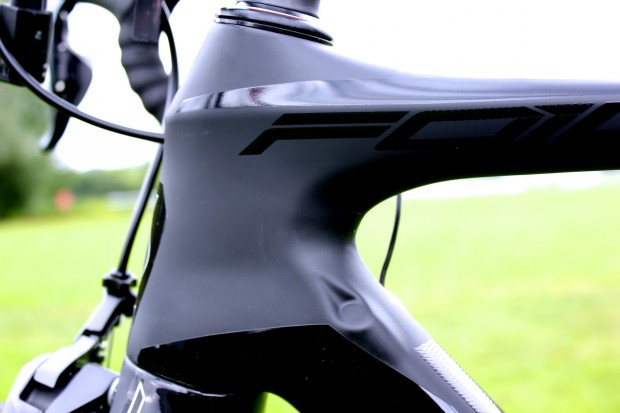
With the return of the Addict commanding much of Scott’s attention, the model year 2014 Foil looks largely unchanged from its predecessor. We wondered if we might have seen a Solace-esque repositioning of the rear brake and the deployment of Shimano’s aero brake calipers, but the conventional units have remained in place.
Further development may be in store next year, perhaps, when design time commanded by the introduction of the Solace and the reintroduction of the Addict, has been freed up. It’s equally possible that Scott have adopted an “ain’t broke, don’t fix it” philosophy for the Foil. The Team Issue was one of the finest bikes we tested last year.
The Foil is a flat-out race bike, a raison d’etre writ large in an aggressive geometry deployed across a range of seven sizes
It’s a flat-out race bike, a raison d’etre writ large in an aggressive geometry deployed across a range of seven sizes, from the 47cm XXS to the 61cm XXL. ‘Long and low’ about covers it. The 52cm frame, for example, unites a 120mm head tube and 460mm seat tube with a 535mm top tube. The head and seat tube angles on the 56cm frame draw close to the classic 73 degree parallel. A sportive bike, it ain’t.
We were shown three models from the Foil range: the 20, 15, and 10. Each uses Scott’s F01 partial aero-foil shape, and the brand’s HMF carbon lay-up, one that uses Toray’s T700 fibre.
Absent from the Foil’s model year 2014 line-up was the Team Issue and the flagship Premium, one with a claimed 830 gram frame weight – light by aero standards. Both use Scott’s HMX lay-up, one fashioned from Toray T800 fibre.
Foil 20
The 20 represents the entry point to the Foil range, with a claimed frame and fork weight of 980 and 380 grams respectively; contributors to an overall weight billed as 8.18kg. The Shimano 105 spec extends as far as the shifters, mechs, and chainset.
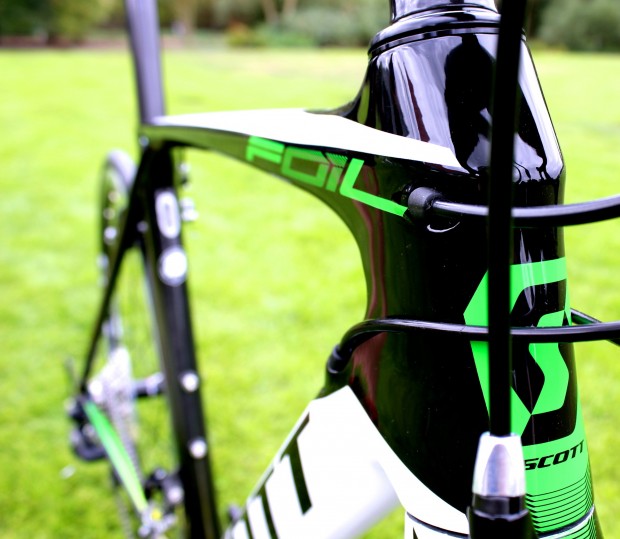
The brake calipers are Shimano’s dual pivot BR-R561, and the chain and cassette are from the downscale but still perfectly functional Tiagra group. Shimano’s modest R501 aluminium clinchers are shod with Continental’s Grand Sport rubber. The Scott Foil 20 costs £1999.
Foil 15
Significantly lighter than the Foil 20 at 7.35kg, and significantly more expensive at £3799, the Foil 15 features the same chassis, but is dressed in Shimano’s 6810 Ultegra 11-speed electronic groupset, deployed in full (shifters, mechs, chainset, and brake calipers). Wheels and finishing kit are from now-house brand, Syncros, and highlights include a Ti-railed saddle. You can find pictures of the Foil 15 in the gallery below.
Foil 10
The ‘10’ monicker identifies this machine as a tier above the ‘15’, but it’s identical chassis is equipped with a (full) mechanical Ultegra groupset and so is £1200 cheaper than its electronically-enhanced cousin at £2599.
In most other regards, the specification is the same, with the exception of the saddle, which has chromoly rails, rather than Ti. The rolling stock is comprised of Syncros RR2.0 aluminium clinchers, laced in a two-cross pattern front and rear, and shod with Continental Grand Sport tyres.
Website: Scott Sports

